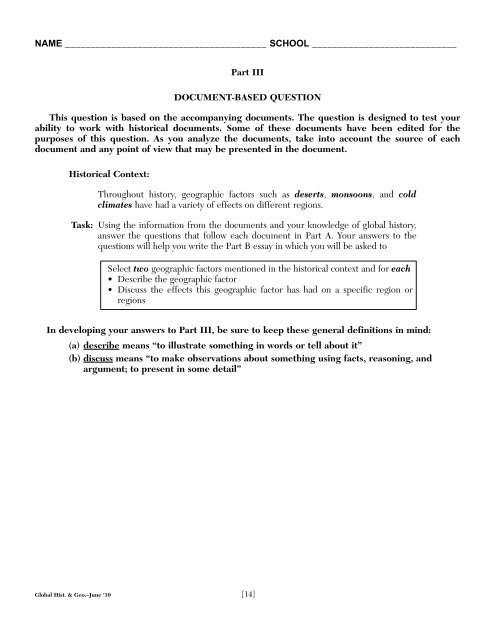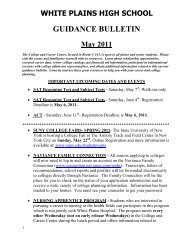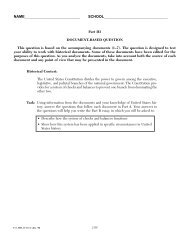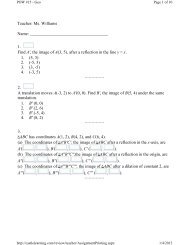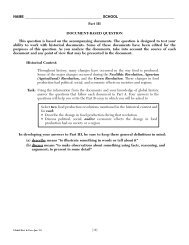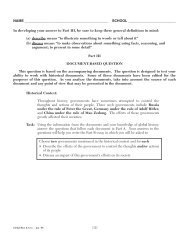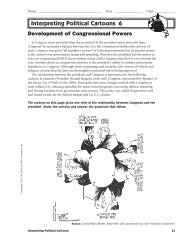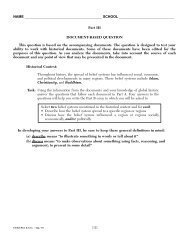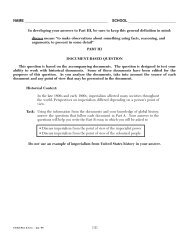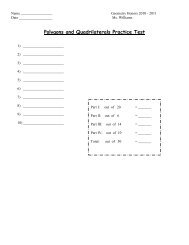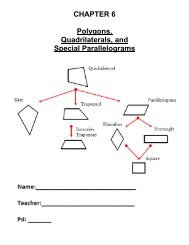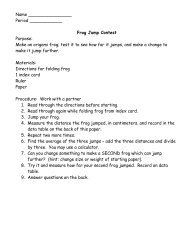DBQ Deserts Monsoons Cold Climates - White Plains Public Schools
DBQ Deserts Monsoons Cold Climates - White Plains Public Schools
DBQ Deserts Monsoons Cold Climates - White Plains Public Schools
Create successful ePaper yourself
Turn your PDF publications into a flip-book with our unique Google optimized e-Paper software.
NAME _______________________________________ SCHOOL ____________________________<br />
Part III<br />
DOCUMENT-BASED QUESTION<br />
This question is based on the accompanying documents. The question is designed to test your<br />
ability to work with historical documents. Some of these documents have been edited for the<br />
purposes of this question. As you analyze the documents, take into account the source of each<br />
document and any point of view that may be presented in the document.<br />
Historical Context:<br />
Throughout history, geographic factors such as deserts, monsoons, and cold<br />
climates have had a variety of effects on different regions.<br />
Task: Using the information from the documents and your knowledge of global history,<br />
answer the questions that follow each document in Part A. Your answers to the<br />
questions will help you write the Part B essay in which you will be asked to<br />
Select two geographic factors mentioned in the historical context and for each<br />
• Describe the geographic factor<br />
• Discuss the effects this geographic factor has had on a specific region or<br />
regions<br />
In developing your answers to Part III, be sure to keep these general definitions in mind:<br />
(a) describe means “to illustrate something in words or tell about it”<br />
(b) discuss means “to make observations about something using facts, reasoning, and<br />
argument; to present in some detail”<br />
Global Hist. & Geo.–June ’10 [14]
Part A<br />
Short-Answer Questions<br />
Directions: Analyze the documents and answer the short-answer questions that follow each document in the<br />
space provided.<br />
Document 1<br />
. . . The aridity of the North African steppe turns to desolation in the Sahara, the most extensive<br />
desert in the world. In popular imagination the Sahara is seen as a wilderness of sand dunes; yet<br />
it is a region of most varied landscapes, ranging from the great massifs [highlands] of Ahaggar<br />
and Tibesti with their extraordinary rock formations and their lofty volcanic peaks to vast<br />
stretches of gravelly plains or broad belts of constantly shifting dunes. The desert is not<br />
completely waterless––in certain parts, particularly on the northern fringes, excellent supplies of<br />
subterranean water support the rich culture of the oases—nor is it completely bereft of [without]<br />
vegetation. Men have thus found it possible to gain a livelihood in the Sahara whether as<br />
cultivators in the oases or pastoralists [herders] in other areas. . . .<br />
Source: Robin Hallett, Africa to 1875: A Modern History, The University of Michigan Press, 1970<br />
1 What is one feature of the Sahara Desert, according to Robin Hallett? [1]<br />
_____________________________________________________________________________________<br />
_____________________________________________________________________________________<br />
Score<br />
Global Hist. & Geo.–June ’10 [15] [OVER]
Document 2<br />
. . . For several centuries, these contacts [between North Africa and the interior] were limited<br />
by the nature of the Sahara itself. More than 3 million square miles in area, the Sahara is the<br />
world’s largest desert. Because temperatures during the day can reach as high as 120 degrees<br />
Fahrenheit and supplies of water are scant, the 40-day journey across the desert required<br />
courage, determination, and careful planning. Travelers who became separated from their<br />
companions were seldom seen again. The trans-Sahara trek became somewhat easier after the<br />
4th century A.D., when camels were introduced in place of horses; camels are able to travel long<br />
distances without water, and their wider hooves make it easier for them to move through sand.<br />
However, intensive contact between North Africa and the interior did not begin until the 7th<br />
century, when a revolutionary change took place in the political and religious life of the region.<br />
By this time, the old empires of the Mediterranean and the Middle East were in decline or in<br />
ruins. In their place was a powerful new force—Islam. . . .<br />
Source: Philip Koslow, Ancient Ghana: The Land of Gold, Chelsea House Publishers<br />
2a What is one reason travel across the Sahara Desert was difficult, according to Philip Koslow? [1]<br />
_____________________________________________________________________________________<br />
_____________________________________________________________________________________<br />
Score<br />
b What change was adopted after the 4th century to make travel easier, according to Philip Koslow? [1]<br />
_____________________________________________________________________________________<br />
_____________________________________________________________________________________<br />
Score<br />
Global Hist. & Geo.–June ’10 [16]
Document 3<br />
. . . Desertification directly affects 1.2 billion people, and more and more productive land is<br />
being lost year by year. It has presented a challenge for governments and aid agencies in over<br />
110 countries for some time, and is a contributing factor in poverty and regional conflicts, for<br />
example in Sudan. It has also been a major issue in Egypt, where 90% of the country’s land mass<br />
is desert. Faced with a rising population, the government has had to undertake a number of<br />
settlement and irrigation projects to create additional living and working space. In China, almost<br />
two-thirds of the country and over 400 million people are affected, the worst hit areas being the<br />
Gobi desert in the northwest of the country and the Takla Makan desert in the west. . . .<br />
Source: Ute Schaeffer, “Deutsche Welle reporters on the ground,”<br />
Down to Earth: News & Views on Desertification,<br />
UNCCD, June 2006, Volume 21<br />
3 What is one challenge areas face because of desertification, according to Ute Schaeffer? [1]<br />
_____________________________________________________________________________________<br />
_____________________________________________________________________________________<br />
Score<br />
Global Hist. & Geo.–June ’10 [17] [OVER]
Document 4<br />
The Subcontinent of India<br />
. . .Only in the northern mountain region do temperatures fall below freezing. The hot season<br />
comes on in March, with temperatures ranging from 80 to 90 degrees along the coasts to well<br />
over 100 degrees in the Indo-Gangetic Plain. The rainy season, brought on by the southwest<br />
monsoon carrying moisture off the Indian Ocean, spans the months of June through September.<br />
Moisture here means as many as 450 inches of rainfall in certain spots along the west coast and<br />
in the state of Assam in the extreme northeast. In the interior and along the east coast, the<br />
summer monsoon has already lost most of its moisture, and rainfall may average only 40 to<br />
80 inches. Moisture from the Bay of Bengal brings about 120 inches of rain to the northeastern<br />
portion of India and Bangladesh. <strong>Monsoons</strong>, winds that blow for a whole season, come twice a<br />
year. The northeast or winter monsoon blows from land to sea in most of the subcontinent and<br />
brings little rain. . . .<br />
Source: James I. Clark, India: The Subcontinent: India, Pakistan, and Bangladesh, McDougal, Littell & Company<br />
4 According to James I. Clark, what is a monsoon? [1]<br />
_____________________________________________________________________________________<br />
_____________________________________________________________________________________<br />
Score<br />
Global Hist. & Geo.–June ’10 [18]
Document 5a<br />
. . . Nature also shaped the rhythms of trade and the places where it was conducted by<br />
constraining [hindering] transportation. All across maritime Asia—from Canton [China] to<br />
Mocca [southern Arabia]—trading schedules were dictated by the monsoon winds. Since strong<br />
winds blew consistently in one direction for several months and then stopped, and then blew<br />
consistently the other way for months, it made no sense to fight those winds. A trader went as<br />
far as he (or occasionally she) could in one direction and then stayed around until the wind<br />
reversed; his goods were then picked up by another merchant who had arrived earlier and knew<br />
precisely how long into the next season he could safely stay and still have enough days of<br />
favorable wind to get home. Thus, instead of Chinese traders spending two or more monsoon<br />
seasons (and years) sailing all the way to, say, Persia with silks, it made more sense to sail out one<br />
monsoon season and exchange with intermediaries based in between and thereby return home<br />
with frankincense and rugs. A series of emporia [trade centers] developed at sites such as Melaka<br />
[Malacca], Surat [India], and the Muscat [Oman] that had more to do with how far one could<br />
travel from there in one sailing season than with what goods could be produced locally. The<br />
result was a remarkably lively and cosmopolitan chain of port cities along the Asian littoral [sea<br />
coast], but in many cases these cities had only weak relationships with their immediate hinterlands<br />
[areas inland from the port]. . . .<br />
Source: Pomeranz and Topik, The World That Trade Created, M. E. Sharpe, 1999 (adapted)<br />
Document 5b<br />
ARABIA<br />
Arabian<br />
Sea<br />
Muscat<br />
Surat<br />
Canton<br />
South<br />
China<br />
Sea<br />
PACIFIC<br />
OCEAN<br />
INDIAN<br />
OCEAN<br />
Monsoon Winds<br />
Straits of<br />
Malacca<br />
Melaka<br />
January<br />
July<br />
Sources: “The West and the Spice Trade,” Calliope, Cobblestone (adapted);<br />
Mountain High Maps, Digital Wisdom (adapted)<br />
5 Based on these documents, what is one way the monsoons affected trade in Southeast Asia? [1]<br />
_____________________________________________________________________________________<br />
_____________________________________________________________________________________<br />
Score<br />
Global Hist. & Geo.–June ’10 [19] [OVER]
Document 6a<br />
Summer 1983<br />
Pushing replaces pedaling when monsoon waters send<br />
the Ganges over its banks to inundate [flood] the city of<br />
Varanasi (Banaras) in Uttar Pradesh. Last year [1983]<br />
the city lay under water mixed with sewage, rotting grain,<br />
and floating carcasses of animals. Elsewhere in the state<br />
flash floods swept away a locomotive and three railcars.<br />
Source: Priit J. Vesilind, “<strong>Monsoons</strong>: Life Breath of Half the World,”<br />
National Geographic, December 1984, Photograph by Steve McCurry<br />
(adapted)<br />
6a What was one problem that people in the Varanasi region of India faced once the 1983 summer monsoons<br />
arrived, based on this National Geographic photograph and its caption? [1]<br />
_____________________________________________________________________________________<br />
_____________________________________________________________________________________<br />
Score<br />
Global Hist. & Geo.–June ’10 [20]
Document 6b<br />
Late <strong>Monsoons</strong><br />
June 9 [1984]<br />
. . . At midnight a stifling silence descended. Air conditioners hiccuped to a halt as electric-power<br />
rationing reached home consumers in [the city of] Trivandrum. All power to heavy industrial<br />
users had already been severed. Now, movie houses were restricted to one showing a day, neon<br />
display lights were outlawed, and stores were compelled to close by sundown. . . .<br />
Across India reservoirs dwindled into puddles as the rains hovered offshore. About half of the<br />
nation’s electricity is generated by hydropower, and thus by the monsoons. Government officials<br />
confessed to newspapers in anxiety that late rains would impede [interfere with] food<br />
production, aggravate inflation, and increase prices—and all this in a preelection year. Prime<br />
Minister Indira Gandhi, touring in Europe, asked for monsoon forecasts to be added to her daily<br />
political briefings. . . .<br />
Source: Priit J. Vesilind, “<strong>Monsoons</strong>: Life Breath of Half the World,” National Geographic, December 1984<br />
6b State two problems regions in India face when the monsoons are late, based on this excerpt from<br />
Priit J. Vesilind’s article. [2]<br />
(1)__________________________________________________________________________________<br />
__________________________________________________________________________________<br />
Score<br />
(2)__________________________________________________________________________________<br />
__________________________________________________________________________________<br />
Score<br />
Global Hist. & Geo.–June ’10 [21] [OVER]
Document 7<br />
. . . Russia has a largely continental climate because of its sheer size and compact configuration.<br />
Most of its land is more than 400 kilometers from the sea, and the center is 3,840 kilometers from<br />
the sea. In addition, Russia’s mountain ranges, predominantly to the south and the east, block<br />
moderating temperatures from the Indian and Pacific oceans, but European Russia and northern<br />
Siberia lack such topographic protection from the Arctic and North Atlantic oceans. . . .<br />
The long, cold winter has a profound impact on almost every aspect of life in the Russian<br />
Federation. It affects where and how long people live and work, what kinds of crops are grown,<br />
and where they are grown (no part of the country has a year-round growing season). The length<br />
and severity of the winter, together with the sharp fluctuations in the mean summer and winter<br />
temperatures, impose special requirements on many branches of the economy. In regions of<br />
permafrost, buildings must be constructed on pilings, machinery must be made of specially<br />
tempered steel, and transportation systems must be engineered to perform reliably in extremely<br />
low and extremely high temperatures. In addition, during extended periods of darkness and cold,<br />
there are increased demands for energy, health care, and textiles. . . .<br />
Source: http://country-studies.us/russia/24.htm<br />
7 According to this information from Country Studies, what is one way the cold winters affect the permafrost<br />
region of Russia? [1]<br />
_____________________________________________________________________________________<br />
_____________________________________________________________________________________<br />
Score<br />
Global Hist. & Geo.–June ’10 [22]
Document 8<br />
Old Man Winter<br />
RAF<br />
To Moscow<br />
Source: Leslie Gilbert Illingworth, November 10, 1941,<br />
Library of Wales, Aberystwyth (adapted)<br />
8 Based on this cartoon by Leslie Gilbert Illingworth, what role did “Old Man Winter” play in the defense of<br />
Russia? [1]<br />
_____________________________________________________________________________________<br />
_____________________________________________________________________________________<br />
Score<br />
Global Hist. & Geo.–June ’10 [23] [OVER]
Document 9<br />
. . . Ardalin’s [a region in the Russian Arctic] unique ecology challenged the Russian and Western<br />
personnel working in the field to find new approaches to preserve the fragile ecosystem of the<br />
Arctic tundra. Because the tundra is particularly vulnerable in summertime, construction and<br />
drilling operations were conducted only in winter to shield the tundra from harmful affects.<br />
Roads were built from ice to transport equipment and supplies to the remote site. When the<br />
ground thawed, helicopters were used to bring in equipment and supplies. . . .<br />
Source: IPIECA, “Conoco in the Russian Arctic: Preserving delicate Arctic ecology<br />
by minimizing the development footprint and environmental impact”<br />
9 What are two ways the Russians have adapted to the challenges of developing the tundra, according to the<br />
International Petroleum Industry Environmental Conservation Association (IPIECA)? [2]<br />
(1)__________________________________________________________________________________<br />
__________________________________________________________________________________<br />
Score<br />
(2)__________________________________________________________________________________<br />
__________________________________________________________________________________<br />
Score<br />
Global Hist. & Geo.–June ’10 [24]
Part B<br />
Essay<br />
Directions: Write a well-organized essay that includes an introduction, several paragraphs, and a conclusion.<br />
Use evidence from at least four documents in your essay. Support your response with relevant<br />
facts, examples, and details. Include additional outside information.<br />
Historical Context:<br />
Throughout history, geographic factors such as deserts, monsoons, and cold<br />
climates have had a variety of effects on different regions.<br />
Task: Using the information from the documents and your knowledge of global history,<br />
write an essay in which you<br />
Select two geographic factors mentioned in the historical context and for each<br />
• Describe the geographic factor<br />
• Discuss the effects this geographic factor has had on a specific region or<br />
regions<br />
Guidelines:<br />
In your essay, be sure to<br />
• Develop all aspects of the task<br />
• Incorporate information from at least four documents<br />
• Incorporate relevant outside information<br />
• Support the theme with relevant facts, examples, and details<br />
• Use a logical and clear plan of organization, including an introduction and a conclusion that<br />
are beyond a restatement of the theme<br />
Global Hist. & Geo.–June ’10 [25]


